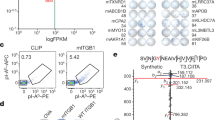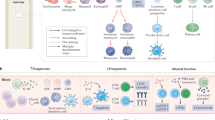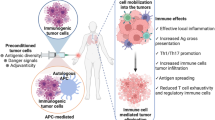Abstract
Many standard and targeted therapies, as well as radiotherapy, have been shown to induce an anti-tumour immune response, and immunotherapies rely on modulating the host immune system to induce an anti-tumour immune response. However, the immune response to such therapies is often reliant on the immunogenicity of a tumour. Tumour immunogenicity varies greatly between cancers of the same type in different individuals and between different types of cancer. So, what do we know about tumour immunogenicity and how might we therapeutically improve tumour immunogenicity? We asked four leading cancer immunologists around the world for their opinions on this important issue.
This is a preview of subscription content, access via your institution
Access options
Subscribe to this journal
Receive 12 print issues and online access
$209.00 per year
only $17.42 per issue
Buy this article
- Purchase on Springer Link
- Instant access to full article PDF
Prices may be subject to local taxes which are calculated during checkout
Similar content being viewed by others
References
Willimsky, G. et al. Immunogenicity of premalignant lesions is the primary cause of general cytotoxic T lymphocyte unresponsiveness. J. Exp. Med. 205, 1687–1700 (2008).
Seung, L. P., Seung, S. K. & Schreiber, H. Antigenic cancer cells that escape immune destruction are stimulated by host cells. Cancer Res. 55, 5094–5100 (1995).
Preiss, S., Kammertoens, T., Lampert, C., Willimsky, G. & Blankenstein, T. Tumor-induced antibodies resemble the response to tissue damage. Int. J. Cancer 115, 456–462 (2005).
Lennerz V. et al. The response of autologous T cells to a human melanoma is dominated by mutated neoantigens. Proc. Natl Acad. Sci. USA 102, 16013–16018 (2005).
Boon, T., Cerottini, J.-C., Van den Eynde, B., van der Bruggen, P. & Van Pel, A. Tumor antigens recognized by T lymphocytes. Annu. Rev. Immunol. 12, 337–365 (1994).
van der Bruggen, P. et al. A gene encoding an antigen recognized by cytolytic T lymphocytes on a human melanoma. Science 254, 1643–1647 (1991).
Gotter, J., Brors, B., Hergenhahn, M. & Kyewski, B. Medullary epithelial cells of the human thymus express a highly diverse selection of tissue-specific genes colocalized in chromosomal clusters. J. Exp. Med. 199, 155–166 (2004).
Kloor, M., Michel, S. & von Knebel Doeberitz, M. Immune evasion of microsatellite unstable colorectal cancers. Int. J. Cancer 127, 1001–1010 (2010).
Casares, N. et al. Caspase-dependent immunogenicity of doxorubicin-induced tumor cell death. J. Exp. Med. 202, 1691–1701 (2005).
Fridman, W. H. et al. Prognostic and predictive impact of intra- and peritumoral immune infiltrates. Cancer Res. 71, 5601–5605 (2011).
Hunder, N. N. et al. Treatment of metastatic melanoma with autologous CD4+ T cells against NY-ESO-1. N. Engl. J. Med. 358, 2698–2703 (2008).
Perez-Diez, A. et al. CD4 cells can be more efficient at tumor rejection than CD8 cells. Blood 109, 5346–5354 (2007).
Zitvogel, L., Tesniere, A. & Kroemer, G. Cancer despite immunosurveillance: immunoselection and immunosubversion. Nature Rev. Immunol. 6, 715–727 (2006).
Dunn, G. P., Bruce, A. T., Ikeda, H., Old, L. J. & Schreiber, R. D. Cancer immunoediting: from immunosurveillance to tumor escape. Nature Immunol. 3, 991–998 (2002).
Klebanoff, C. A., Gattinoni, L. & Restifo, N. P. CD8+ T-cell memory in tumor immunology and immunotherapy. Immunol. Rev. 211, 214–224 (2006).
Tredan, O., Galmarini, C. M., Patel, K. & Tannock, I. F. Drug resistance and the solid tumor microenvironment. J. Natl Cancer Inst. 99, 1441–1454 (2007).
Hamzah, J. et al. Vascular normalization in Rgs5-deficient tumours promotes immune destruction. Nature 453, 410–414 (2008).
Buckanovich, R. J. et al. Endothelin B receptor mediates the endothelial barrier to T cell homing to tumors and disables immune therapy. Nature Med. 14, 28–36 (2008).
Burnet, F. M. Immunological factors in the process of carcino-genesis. Br. Med. Bull. 20L, 154–158 (1964).
Thomas, L. On immunosurveillance in human cancer. Yale J. Biol. Med. 55, 329–333 (1982).
Langman, R. E., Cohn, M. A minimal model for the self-non-self discrimination: a return to the basics. Semin. Immunol. 12, 189–195 (2000).
Dunn, G. P., Old, L. J. & Schreiber, R. D. The immunobiology of Cancer Immunosurveillance and Immunoediting. Immunity 21, 137–148 (2004).
Pradeu, T. & Carosella, E. D. On the definition of a criterion of immunogenicity. Proc. Natl Acad. Sci. USA 103, 17858–17861 (2006).
Drake, C. G., Jaffee, E. M. & Pardoll, D. M. Mechanisms of immune evasion by tumors. Adv. Immunol. 90, 51–81 (2006).
Laheru, D. A. & Jaffee, E. M. Immunotherapy for pancreatic cancer – science driving clinical practice. Nature Rev. Cancer 5, 459–467 (2005).
Cohn, M. The immune system: a weapon of mass destruction invented by evolution to even the odds during the war of the DNAs. Immunol. Rev. 185, 24–38 (1992).
Khong, H. T. & Restifo, N. P. Natural selection of tumor variants in the generation of “tumor escape” variants. Nature Immunol. 3, 999–1005 (2002).
Klein, G. & Klein, E. Immune surveillance against virus-induced tumors and nonrejectability of spontaneous tumors: contrasting consequences of host versus tumor evolution. Proc. Natl Acad. Sci. USA 74, 2121–2125 (1977).
Shankaran, V. et al. IFNγ and lymphocytes prevent primary tumour development and shape tumour immunogenicity. Nature 410, 1107–1111 (2001).
Qin, Z. & Blankenstein, T. A cancer immunosurveillance controversy. Nature Immunol. 5, 3–4 (2004).
Kammertoens, T., Qin, Z., Briesemeister, D., Bendelac, A. & Blankenstein, T. Methylcholanthrene-induced carcinogenesis is promoted by B-cells and IL-4 but there is no evidence for a role of T/NKT-cells and their effector molecules (Fas-ligand, TNF-α, perforin). Int. J. Cancer 31 Jan 2012 (doi:10.1002/ijc.27411).
Pantel, K. & Uhr, J. W. Controversies in clinical cancer dormancy. Proc. Natl Acad. Sci. USA 108, 12396–12400 (2011).
Garrido, F., Cabrera, T. & Aptsiauri, N. “Hard” and “soft” lesions underlying the HLA class I alterations in cancer cells: implications for immunotherapy. Int. J. Cancer 127, 249–256 (2010).
Gajewski, T. F. et al. Immune resistance orchestrated by the tumor microenvironment. Immunol. Rev. 213, 131–145 (2006).
Uyttenhove, C. et al. Evidence for a tumoral immune resistance mechanism based on tryptophan degradation by indoleamine 2,3-dioxygenase. Nature Med. 9, 1269–1274 (2003).
Opitz, C. A. et al. An endogenous tumour-promoting ligand of the human aryl hydrocarbon receptor. Nature 478, 197–203 (2011).
Pilotte, L. et al. Reversal of tumoral immune resistance by inhibition of tryptophan 2,3-dioxygenase. Proc. Natl Acad. Sci. USA 109, 2497–2502 (2012).
Demotte, N. et al. A galectin-3 ligand corrects the impaired function of human CD4 and CD8 tumor-infiltrating lymphocytes and favors tumor rejection in mice. Cancer Res. 70, 7476–7488 (2010).
Curiel, T. J. et al. Specific recruitment of regulatory T cells in ovarian carcinoma fosters immune privilege and predicts reduced survival. Nature Med. 10, 942–949 (2004).
Gobert, M. et al. Regulatory T cells recruited through CCL22/CCR4 are selectively activated in lymphoid infiltrates surrounding primary breast tumors and lead to an adverse clinical outcome. Cancer Res. 69, 2000–2009 (2009).
Gabrilovich, D. I. & Nagaraj, S. Myeloid-derived suppressor cells as regulators of the immune system. Nature Rev. Immunol. 9, 162–174 (2009).
Boon, T., Coulie, P. G., Van den Eynde, B. & van der Bruggen, P. Human T cell responses against melanoma. Annu. Rev. Immunol. 24, 175–208 (2006).
Corbière, V. et al. Antigen spreading contributes to MAGE vaccination-induced regression of melanoma metastases. Cancer Res. 71, 1253–1262 (2011).
Willimsky, G. & Blankenstein, T. Sporadic immunogenic tumours avoid destruction by inducing T-cell tolerance. Nature 437, 141–146 (2005).
Neefjes, J., Jongsma, M. L., Paul, P. & Bakke, O. Towards a systems understanding of MHC class I and MHC class II antigen presentation. Nature Rev. Immunol. 11, 823–836 (2011).
Rezvani, K. & de lavallade, H. Vaccination strategies for lymphomas and leukemias: recent progress. Drugs 71, 1659–1674 (2011).
Scanlan, M. J., Gure, A. O., Jungbluth, A. A., Old, L. J. & Chen, Y. T. Cancer/testis antigens: an expanding family of targets for cancer immunotherapy. Immunol. Rev. 188, 22–32 (2002).
Zheng, L. et al. Tyrosine 23 phosphorylation-dependent cell-surface localization of annexin A2 is required for invasion and metastases of pancreatic cancer. PLoS ONE 6, e19390 (2011).
Lampen, M. H. & van Hall, T. Strategies to counteract MHC-1 defects in tumors. Curr. Opin. Immunol. 23, 293–298 (2011).
Topalian, S. L., Weiner, G. J. & Pardoll, D. M. Cancer immunotherapy comes of age. J. Clin. Oncol. 29, 4828–4836 (2011).
Schietinger, A., Delrow, J. J., Basom, R. S., Blattman, J. N. & Greenberg, P. D. Rescued tolerant CD8 T cells are preprogrammed to reestablish the tolerant state. Science 335, 723–727 (2012).
Ganss, R. & Hanahan, D. Tumor microenvironment can restrict the effectiveness of activated antitumor lymphocytes. Cancer Res. 58, 4673–4681 (1998).
Huber, M. L., Haynes, L., Parker, C. & Iversen, P. Interdisciplinary critique of Sipuleucel-T as immunotherapy in castration-resistant prostate cancer. J. Natl Cancer Inst. 104, 1–7 (2012).
Horowitz, M. M. et al. Graft-versus-Leukemia reactions after bone marrow transplantation. Blood 75, 555–562 (1990).
Wilde, S. et al. Dendritic cells pulsed with RNA encoding allogenic MHC and antigen induce T cells with superior anti-tumor activity and higher functional TCR avidity. Blood 114, 2131–2139 (2009).
Li, L.-P. et al. Transgenic mice with a diverse human T-cell antigen receptor repertoire. Nature Med. 16, 1029–1034 (2010).
Schumacher, T. N. T-cell-receptor gene therapy. Natur. Rev. Immunol. 2, 512–519 (2002).
Offringa, R. Antigen choice in adoptive T-cell therapy of cancer. Curr. Opin. Immunol. 21, 190–199 (2009).
Nair, S. et al. Synergy between tumor immunotherapy and antiangiogenic therapy. Blood 102, 964–971 (2003).
Niethammer, A. G. et al. A DNA vaccine against VEGF receptor 2 prevents effective angiogenesis and inhibits tumor growth. Nature Med. 8, 1369–1375 (2002).
Pastor, F., Kolonias, D., Giangrande, P. H. & Gilboa, E. Induction of tumour immunity by targeted inhibition of nonsense-mediated mRNA decay. Nature 465, 227–230 (2010).
Pastor, F., Kolonias, D., McNamara, J. O. & Gilboa, E. Targeting 4–1BB costimulation to disseminated tumor lesions with bi-specific oligonucleotide aptamers. Mol. Ther. 19, 1878–1886 (2011).
Gattinoni, L. et al. Wnt signaling arrests effector T cell differentiation and generates CD8+ memory stem cells. Nature Med. 15, 808–813 (2009).
Olive, K. P. et al. Inhibition of Hedgehog signaling enhances delivery of chemotherapy in a mouse model of pancreatic cancer. Science 324, 1457–1461 (2009).
Sugahara, K. N. et al. Coadministration of a tumor-penetrating peptide enhances the efficacy of cancer drugs. Science 328, 1031–1035 (2010).
Ma, Y. et al. Chemotherapy and radiotherapy: cryptic anticancer vaccines. Sem. Immunol. 22, 113–124 (2010).
Kantoff, P. W. et al. Sipuleucel-T immunotherapy for castration-resistant prostate cancer. N. Engl. J. Med. 363, 411–422 (2010).
Hodi, F. S. et al. Improved survival with Ipilimumab in patients with metastatic melanoma. N. Engl. J. Med. 363, 711–723 (2010).
Acknowledgements
L.M.J. wishes to thank The Skip Viragh Pancreatic Cancer Center.
Author information
Authors and Affiliations
Corresponding authors
Ethics declarations
Competing interests
The authors declare no competing financial interests.
Related links
Glossary
- Adaptive immune responses
-
Responses mediated by antigen-specific lymphocytes and antibodies, they are highly antigen-specific and include the development of immunological memory.
- Allogeneic
-
From different individuals of the same species.
- Anergic
-
A state in which T cells are unresponsive and cannot be activated by antigen.
- Antigenicity
-
The ability to be recognized by the immune system by binding to T and B cell receptors, although this might not result in overt responses.
- Autochthonous
-
Formed from endogenous tissue in the correct anatomical location.
- Cancer-germline genes
-
Embryonic genes that are normally only expressed in male germline cells that become expressed in cancer. Can also be described as cancer-testis genes.
- Desmoplasia
-
The growth of fibrous or connective tissue.
- DNA mismatch repair
-
DNA repair mechanism that corrects mispaired nucleotides that originate during DNA replication and recombination.
- Graft-versus-host disease
-
Inflammatory and tissue-destructive immune reactions that result from the attack on host tissues by infused allogeneic lymphocytes.
- Graft-versus-leukaemia
-
Following allogeneic transplantation of bone marrow or blood stem cells, donor T cells may recognize peptides on leukaemia cells that result in beneficial immune attack.
- Human leukocyte antigen
-
Cell-surface molecules that are encoded by the major histocompatibility complex. These molecules present antigenic peptides to T cells. HLA class I molecules present antigen to CD8+ T lymphocytes, and HLA class II molecules present antigen to CD4+ T lymphocytes.
- Immunoediting
-
Describes the complex relationship between a developing tumour that is under constant pressure from the host immune system. Cancer immunoediting consists of three phases: elimination (that is, cancer immunosurveillance), equilibrium and escape.
- Lymphopenia
-
Reduced numbers of lymphocytes, commonly following radiotherapy or chemotherapy.
- Minor histocompatibility
-
Polymorphic peptides derived from normal cellular proteins that can be recognized in the context of major histocompatibility complex molecules. Immune responses against these polymorphic antigens can result in graft-versus-host reactions, graft rejection or beneficial anti-tumour responses.
- Regulatory T (TReg) cells
-
A T cell subpopulation that suppresses the activation of other T cells and that maintains immune system homeostasis and peripheral tolerance to self-antigens.
- Syngeneic
-
Genetically identical.
- Tolerance
-
The process that ensures that repertoires of B cells and T cells are biased against self-reactivity, which reduces the likelihood of autoimmunity.
Rights and permissions
About this article
Cite this article
Blankenstein, T., Coulie, P., Gilboa, E. et al. The determinants of tumour immunogenicity. Nat Rev Cancer 12, 307–313 (2012). https://doi.org/10.1038/nrc3246
Published:
Issue Date:
DOI: https://doi.org/10.1038/nrc3246
This article is cited by
-
Intratumoral Injection of Large Surface Area Microparticle Taxanes in Carcinomas Increases Immune Effector Cell Concentrations, Checkpoint Expression, and Synergy with Checkpoint Inhibitors: A Review of Preclinical and Clinical Studies
Oncology and Therapy (2024)
-
Mechanisms of HIF-driven immunosuppression in tumour microenvironment
Journal of the Egyptian National Cancer Institute (2023)
-
Phase-transition nanodroplets with immunomodulatory capabilities for potentiating mild magnetic hyperthermia to inhibit tumour proliferation and metastasis
Journal of Nanobiotechnology (2023)
-
Colorectal Cancer and Tumor Stromal Cells Have Different Effects on the Differentiation and Maturation of Dendritic Cells In Vitro
Bulletin of Experimental Biology and Medicine (2023)
-
A single magnetic nanoplatform-mediated combination therapy of immune checkpoint silencing and magnetic hyperthermia for enhanced anti-cancer immunity
Nano Research (2023)



